Ghirza: Mausoleum South-A
Q69122169Ghirza: Roman town in Libya, one of the main archaeological sites of the country.
Ghirza: Mausoleum South-A
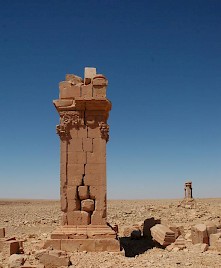
The first photo shows the two main surviving monuments of Ghirza's South Cemetery, which is about two kilometer west of the town itself. In front is Mausoleum A. In Graeme Barker e.a., Farming the Desert. The UNESCO Libyan Valleys Archaeological Survey (1996), this cemetry is known as Gh128.
The South Cemetery contains the mausoleums of one of the two clans in Ghirza; because there are no inscriptions, their name is not known. Unlike the tombs on the North Cemetery, which looked like temples, the monuments on this cemetery are obelisk-shaped, a common form in Tripolitana, inspired by Phoenician examples.
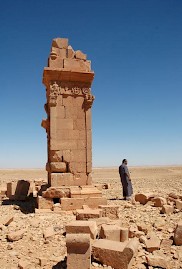
This monument must have looked like the ones at Sabratha, Wadi el-Amud, or Msletten, or the other Msletten. Again, we find the false door with architrave that was believed to give access to the afterlife (as those doors did in ancient Egypt), and again we find a combination of artistic traditions: the columns are Roman, but the needle shape of the monument is not.
Unfortunately, only the lowest of three tiers has survived, but the bases of the columns of the second tier, which probably had the same height as the lowest one, have survived, so we know that it consisted of a square core and four columns. On the highest level, a very steep pyramid must have pointed to heaven. It was at least fifteen meters high and must have been an important landmark for travelers arriving from the desert.
On top of the Corinthian columns was a frieze, which contained several of the usual motifs. On the photo below lef, we can see portraits of a woman, a child, and a bearded man. On the other side of the monument (second photo), we can see a woman with an amphora, a portrait, and two flowers. To the right is an unidentified figure that appears to fly away (a soul?). Similar figures can be seen on the ceiling of the rock tomb of Janzur.
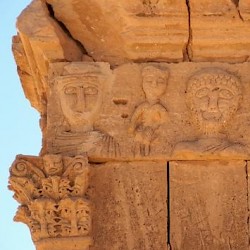 Ghirza, Mausoleum South A, deceased |
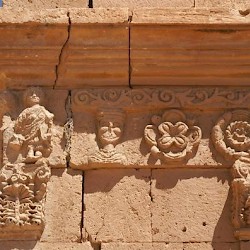 Ghirza, Mausoleum South A, decoration |
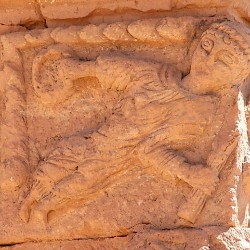 Ghirza, Mausoleum South A, spirit of the deceased |
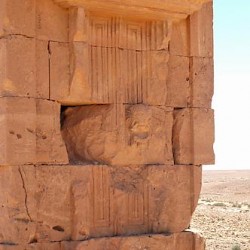 Ghirza, Mausoleum South A, false door |